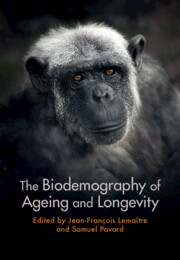Book contents
- The Biodemography of Ageing and Longevity
- The Biodemography of Ageing and Longevity
- Copyright page
- Dedication
- Contents
- Contributors
- Foreword
- Acknowledgements
- 1 The Eternal Youth of Ageing Research
- 2 Theories of Ageing across Ages
- 3 The Diversity of Longevity Metrics
- 4 The Meaning of ‘Exceptional Longevity’
- 5 The Inevitability of Senescence
- 6 The Untapped Potential of Zoo and Aquarium Data for the Comparative Biology of Ageing
- 7 Perspectives in Comparative Biology of Ageing
- 8 An Integrative Approach to Understanding Variation in the Form, Pattern and Pace of Ageing
- 9 Sex Differences in Lifespan, Ageing and Health in the Living World
- 10 Evolution of Human Reproduction, Ageing and Longevity
- 11 Lifespan and Mortality in Hunter-Gatherer and Other Subsistence Populations
- 12 Longevity in Modern Populations
- 13 Health Transition and Population Ageing
- 14 Limit of Human Longevity
- 15 Mortality Modelling at the Oldest Ages in Human Populations
- 16 Lessons from Exceptionally Long-Lived Individuals and Long-Living Families
- 17 Human Populations with Extreme Longevities
- 18 Socio-Economic Consequences of Increased Longevity in Contemporary Populations
- Index
- References
9 - Sex Differences in Lifespan, Ageing and Health in the Living World
What Can We Learn from Evolutionary Biology?
Published online by Cambridge University Press: 14 November 2024
- The Biodemography of Ageing and Longevity
- The Biodemography of Ageing and Longevity
- Copyright page
- Dedication
- Contents
- Contributors
- Foreword
- Acknowledgements
- 1 The Eternal Youth of Ageing Research
- 2 Theories of Ageing across Ages
- 3 The Diversity of Longevity Metrics
- 4 The Meaning of ‘Exceptional Longevity’
- 5 The Inevitability of Senescence
- 6 The Untapped Potential of Zoo and Aquarium Data for the Comparative Biology of Ageing
- 7 Perspectives in Comparative Biology of Ageing
- 8 An Integrative Approach to Understanding Variation in the Form, Pattern and Pace of Ageing
- 9 Sex Differences in Lifespan, Ageing and Health in the Living World
- 10 Evolution of Human Reproduction, Ageing and Longevity
- 11 Lifespan and Mortality in Hunter-Gatherer and Other Subsistence Populations
- 12 Longevity in Modern Populations
- 13 Health Transition and Population Ageing
- 14 Limit of Human Longevity
- 15 Mortality Modelling at the Oldest Ages in Human Populations
- 16 Lessons from Exceptionally Long-Lived Individuals and Long-Living Families
- 17 Human Populations with Extreme Longevities
- 18 Socio-Economic Consequences of Increased Longevity in Contemporary Populations
- Index
- References
Summary
Sex differences in lifespan have been labelled as one of the most robust features in biology. In human populations, women live consistently longer than men, a pattern that encompasses most mammalian species. However, when expanding both the taxonomic scope beyond mammals and the range of mortality metrics the female survival advantage over males is no longer the rule. Moreover, current evidence suggests that sex differences in actuarial ageing parameters (i.e. age at the onset of ageing and rate of ageing) are far from consistent across the tree of life. This chapter first reviews current knowledge of sex differences in mortality patterns across animals and appraises how these diverse patterns can be explained by the current evolutionary framework. It then emphasizes the relevance of going beyond the differences in mortality patterns by exploring how natural and sexual selection have shaped age- and sex-specific changes in reproductive performance and body mass across the tree of life, and by identifying some possible biological pathways modulating ageing in a sex-specific way. Finally, it highlights how evolutionary theories can be relevant to understand the widespread differences in causes of death between sexes, offering a complementary approach to gain a comprehensive understanding of the evolution of sex differences in health and ageing, with likely biomedical implications.
Keywords
- Type
- Chapter
- Information
- The Biodemography of Ageing and Longevity , pp. 162 - 189Publisher: Cambridge University PressPrint publication year: 2024

